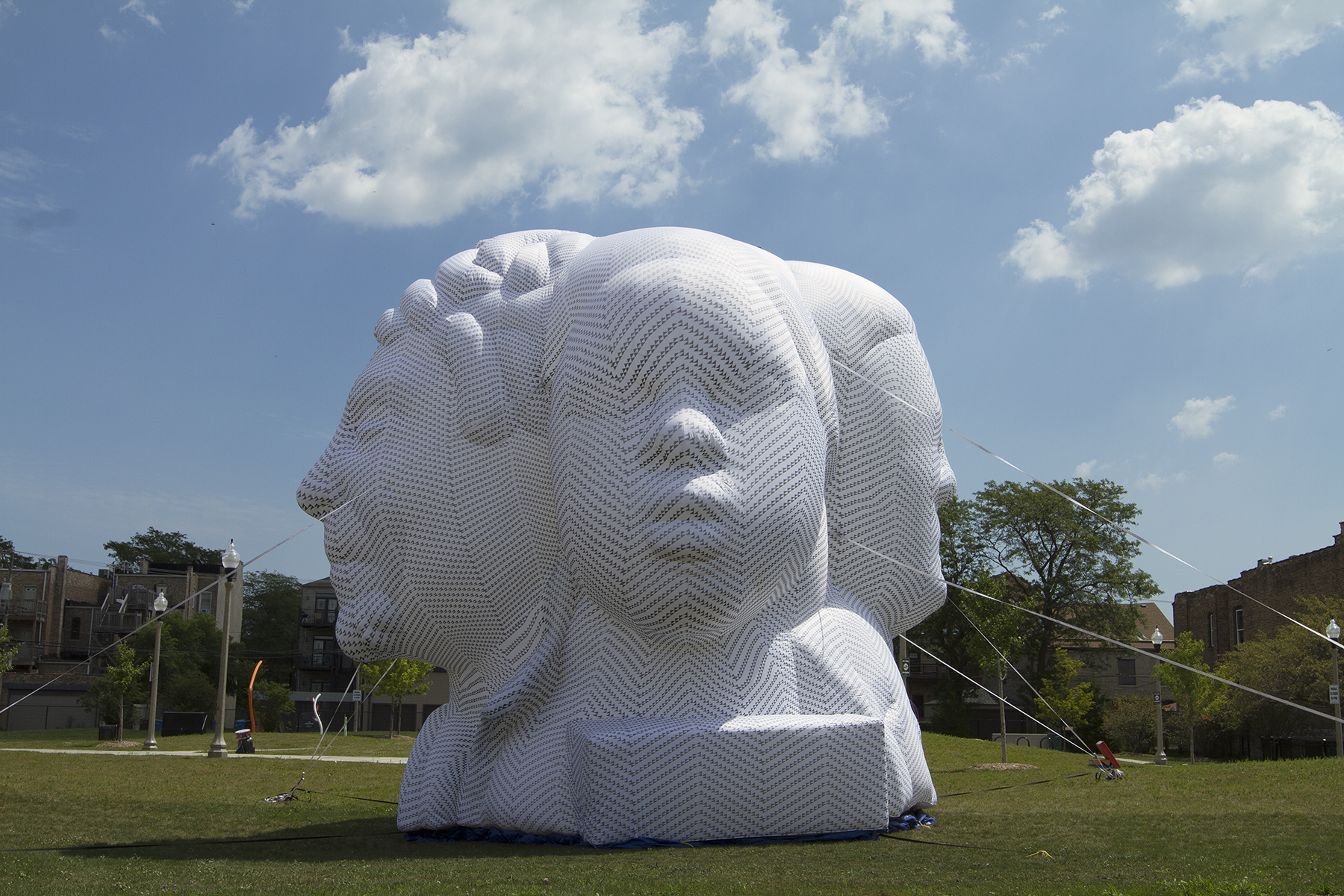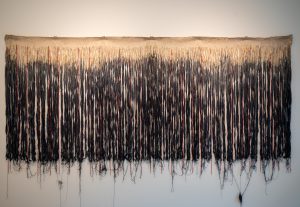Floating Museum does not look like your typical arts collective. Their public installations and artworks incorporate the ways people navigate the city’s infrastructure. Since 2016, Floating Museum’s practice has evolved from increasingly regular installations in the city’s parks to the widely celebrated River Assembly, in which artworks from collaborators across the city were floated on a barge on the Chicago River — not an easy feat. This summer, Floating Museum took on a new infrastructure challenge: the Chicago Transit Authority, or CTA.
Their latest project, Cultural Transit Assembly, partners with the CTA and the Chicago Park District to focus on the CTA Green Line, utilizing train cars as gallery and performance space. They simultaneously made use of community sites adjacent to the train line as locations for their weekly pop-up installation of a 25-foot-tall inflatable sculpture, Founders, which blends Chicago history with their desire to connect local institutions such as The Field Museum and the DuSable Museum of African American History.
I sat down with Faheem Majeed and Jeremiah Hulsebos-Spofford, two of the founders and co-directors of Floating Museum, to have a conversation about the summer installations and activities, building bridges between institutions, and planting seeds for future artworks and collaborations.
This interview has been edited for length and clarity.
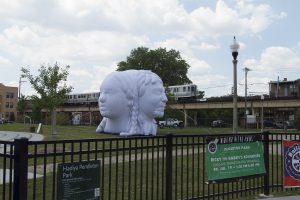
Michael Sullivan: Can you talk about how you started Cultural Transit Assembly? Where did the idea for the project come from?
Jeremiah Hulsebos-Spofford: We started thinking about CTA after we did a project in 2017 called River Assembly on the Chicago River. The Chicago river is pretty unique because it traverses a big swath of the city and moves through a lot of neighborhoods, and we were looking at the train because it does a similar thing.
We were looking to move from the river to the train as a way to move through neighborhoods where we have a lot of community partners, but also the way that you can view the city. It’s like a huge viewing machine because it’s a raised platform in a lot of places and it’s a great way to look out upon the city. We were thinking about activating a lot of different neighborhoods as galleries, and we were thinking, what better way? It’s built in that for $2.50 you could move around the whole museum essentially — if the city is the museum — and then go to a bunch of different exhibitions and art activations throughout the city.
MS: Can you describe what Founders is and how that works?
Faheem Majeed: With Founders, we were thinking a lot about modularity and the ability to move around. Founders actually builds on and is kind of a continuation of a sculpture we created for River Assembly. In essence, thinking about the founding of Chicago, but also drawing attention to Jean Baptiste Point du Sable, the first non-Indigenous settler of Chicago, drawing attention to his importance. Initially in River Assembly we were trying to think about the park that was designated by Harold Washington back in the ‘80s as kind of a destination point coming down the river, because it’s at the mouth of the river downtown.
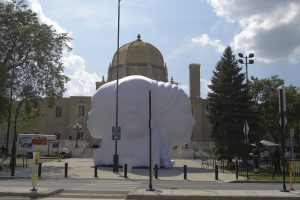
As we went down the river and thought about that and had drawn attention to that, we started to learn (or not learn) more about [du Sable’s] wife Kitihawa, who was Potawatomi, and that they married and had children together. It was because of that marriage he was able to trade on the behest of the Potawatomi tribe. We just found it interesting that, in a moment of trying to draw attention to a history that a lot of people don’t know about, once again someone else was invisible.
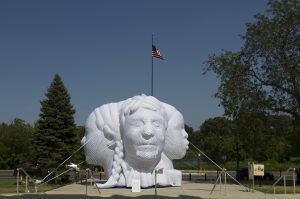
So we started to build on that, and we’ve been working with a group of people to think about that. Museum collections: looking at their Potawatomi collections in The Field Museum, looking at collections in the DuSable Museum. That kind of comes out of these collections and partnerships. So on Founders, rather than one head, there are four heads. The heads are Jean Baptiste Point du Sable, which was modelled by one of our partners Etzer Cantave, who is a long time advocate for DuSable Park and of Haitian descent; and Kitihawa, who was modelled by one of our other partners, an artist Monica Rickert-Bolter, who is Potawatomi and African American; because there are no images of these people. The last two pieces are from DuSable Museum’s collection. One is Harold Washington and one is Unnamed Boy, by an artist named William Ellisworth Artis, that’s from a collection. It’s building on this notion of a museum, how to make collections accessible, thinking about scanning, scaling, and things like that. That’s important to us to think about these collections and access.
The skin of it, the pattern is inspired by Potawatomi textiles from the Field Museum. It’s quite a complex thing that a lot of people may never get to the layers. But two things when people see it, they either, you know, it’s kind of like a Mount Rushmore if you think about honoring with scale and that thing moving around; and then also people want a bounce house. Ha! So that’s the first, it’s like, “Oh, it’s a bounce house! Great!”
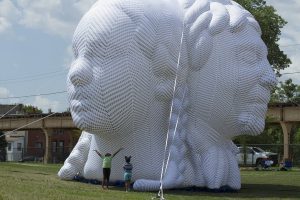
JHS: Does the mouth open?
FM: Can we go inside? And we say, no it’s a sculpture.
JHS: Maybe next time.
FM: So our harshest critics are the children who want to climb inside of it.
MS: I mean, you see them run up and they’re like, so stoked.
FM: Ha! Then they’re like, aww.
MS: Because everyone recognizes that inflatable sort of look. Like, this is fun so let’s go check it out.
JHS: Absolutely.
FM: Then they’re just totally deflated and mad at us. We also wanted it from a distance, because of the pattern work and the way it looks, you don’t know if it’s stone, or you don’t quite know if it’s permanent or if it’s temporary.
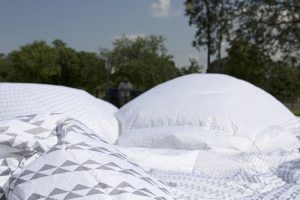
JHS: Yeah, and the inflatable is a really great medium, obviously, because it’s a mobile medium. It packs up pretty tight and we can move it up and down the Green Line. Thinking a little bit of future Founders or more work that we’re gonna do, it presents a super, great opportunity to get big institutions together in one artwork, in one collaboration. The Field Museum is rubbing up against the DuSable Museum pretty literally in the work; and that’s pretty exciting to us moving forward: making these artworks that are essentially these big, sprawling collaborations.
MS: Do you feel like you’ve been successful as a bridge in that way? Within the work the collections from each maybe are touching, but do you feel like you’re starting to make those connections between institutions?
FM: Yeah, if you think of the bridges, that’s exactly what it is. It’s not only between the institutions, but also the community partners. Thinking about museums’ interests, number one getting more traffic into their spaces, but ethically thinking about how to have sustainable relationships. We present an adjacent model, which I think a lot of the museum people we work with are really excited about. They haven’t quite figured out how to incorporate it yet, but it’s about planting seeds. So, in terms of making bridges, I guess you have [the Golden Gate] Bridge; and we’re more of a rope bridge right now. Ha!
JHS: Ha, over like a little creek.
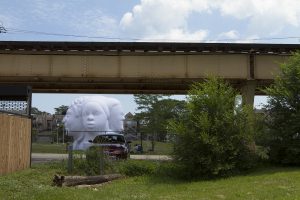
FM: Over a creek! No, actually over a massive body of water, because sometimes it can get pretty rocky; these lumbering, big institutions, and we come in and we’re kind of a blip on the map. Because of our relationships with individuals in those institutions we make a lot of leeway, because we consider those individuals to be part of our Floating Museum collective. We can’t do these things without lots of support from a lot of municipalities and institutions.
But in the same sort of way, it is about connecting to a lot of different, smaller institutions that oftentimes have had very challenging relationships with these larger institutions. I think it’s just a function of budget size, time, and capacity. As a collective we can come in and out of these spaces and set some models. We get invited to a lot of talks and to consult a lot with museums and organizations. How can we do this thing, or can you help us with this thing?
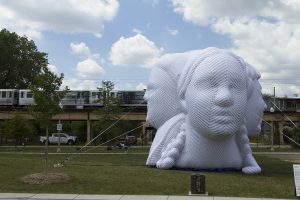
MS: Can you talk about the train wrapping, and that aspect of activating spaces around the train line, but also the train itself?
JHS: Yeah, again it’s sort of thinking about the city as a museum, and the sort of galleries as neighborhood galleries. We were pretty excited that there’s gonna be a couple of installations in the parks next to the train, but then there’s also installations in the train, and then wrapping two of the train cars. The theme is similar, thinking about Founders. There’s a Kitihawa train and a du Sable train with their large faces on the exterior. One of them is seen from very far away, optically it comes together, and then the other one you can see if you’re on the train platform. On the inside, artwork was curated trying to envision what these people looked like, because there aren’t any photos. We were really excited about that. It was pre-photo, yet the stories have lived on. Artists have made tons of representations, and we were really interested in getting these representations together into the space of this train that’s moving up and down the Green Line. So in the inside installation are all of these different Kitihawa and du Sable images that we commissioned. Then every so often it moves in front of the Founders balloon. So there’s sort of an intersection with the Founders sculpture.
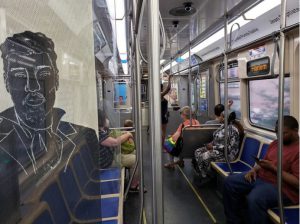
FM: Also on the inside, it’s like a partial install, above are the various names, the various spellings and various ways that their names are said. It’s kind of like speaking someone into being. Especially Kitihawa, who also went by Catherine. Their names are written up there, and on that train it’s all Native and Indigenous artists, First Nations artists, making depictions or representations of that spirit of her. Then on the other one are a number of artists of African descent, or African American, making depictions of Jean Baptiste Point du Sable. It’s kind of like open sourcing imagery and letting more people get to decide what something looks like, getting them to ponder about that. Each one of them is commissioned. We worked with a number of artists and one of the things we try to do in our fundraising is actually create stipends for artists to either just share their work or make new work. That’s something, once again thinking about museum models, about paying or supporting people to do the things that they do. That’s something we take great pride in. We would love for it to be more, but it’s a start.
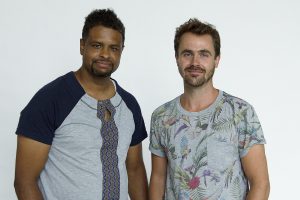
MS: I know that there are a lot of aspects to it, but can you talk a little bit about the significance of the ‘floating’ in Floating Museum? Sometimes it’s literal and sometimes it’s not.
JHS: We sort of came to “floating,” it gives us some flexibility. You can float on the water, you can float in the air, and also we’re floating through neighborhoods in a certain sense, because the train is moving and there’s an installation that’s moving. But in another sense it’s the complete opposite. We’re very grounded in certain neighborhoods, with partnerships and relationships, and we’ve been working over a number of years on those community relationships. I think I like the word floating because it sort of gives possibility that both of those things can exist at the same time. I think it also sparks people’s imaginations. It’s a good entryway, like, what is art? You know, art — depending on your background and how much art you’ve had in your life — there can be barriers there. Floating, sometimes, is a good entry point.
FM: Yeah, it is confusing for a lot of people because our first really, really visible project was floating down the river. So people are like, “Oh, Chicago’s first ‘floating museum’!” and the mayor was just like, “Oh, great! We’re gonna be floating on the river every summer!” We’re like, eh… no… yeah, no. I mean, actually our interests are the neighborhoods, and when we were floating down the river the idea was to tap into those neighborhoods adjacent to the river. So yeah, we do get a lot of people asking about waterways, which is fine. But when this project is said and done with the CTA (Chicago Transit Authority) and there’s no water involved people will start to understand that Floating is about floating not literally on water, but floating through the city. That was one of the reasons why we have to have an alternate narrative. But we do like the magic of the word float. We kind of play with that a lot, too.
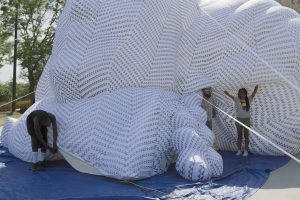
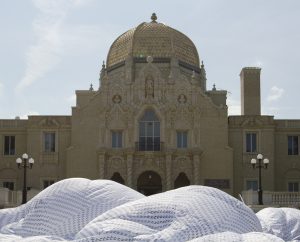
JHS: Yeah, we are though — we’re going to Denmark to do a Floating Museum on the water. So there’s gonna be floating on the water in our future.
FM: Yes. We will return to the water, but also to the air, and lots of different things. The hope is as we do these things we will continue to build on our partnerships with our artists; not only showing art in our neighborhoods, but maybe some of our neighborhoods actually going around the world with us.
MS: You’re focusing on, or looking at different areas of the city, different neighborhoods. Why did you choose the Green Line in particular to focus on, moving around it?
FM: The Green Line goes south to Englewood and Woodlawn, and then it goes west. It goes downtown, then cuts and goes far west to Austin before you hit Oak Park. Once again, if you think about spaces that aren’t often focused on for their contributions creatively, these are two areas that are important. So thinking about how they connect, West and South, it was the one that made the most sense to us. We had already been working with Austin Town Hall; and that sits right on the park as well. So for a lot of reasons it made sense.
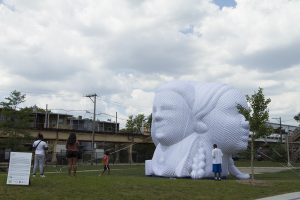
MS: What’s been the reaction? I see a lot of people walk up, check it out, and they’re very curious. People are definitely interested, because it’s this huge thing that you can see from a ways away. What kind of questions are people asking you when they’re coming up? What are their interests, seeing these sculptures that are floating around?
JHS: We just had an Uber driver stop in front of our installation at Harding Park, where Founders is, and he was asking, “Who are they?” I think that– obviously you can see that they’re busts, and that for me was pretty exciting because I think that as a conversation piece that’s the point of it: to start a conversation about history. That was an exciting reaction; and then we’ve gotten a lot of shoutouts online from people who might have come during the hours that it’s up, or ridden the train, and it’s been pretty great. We had one guy give a shout out that you could go to Chicago’s newest museum for $2.50 on the train. That, again, is pretty great, just thinking about our mission.
FM: There’s also some confusion.
JHS: Some confusion. It might look like a big alien! You know, popping up pretty quick in a place where it’s generally just an empty park.
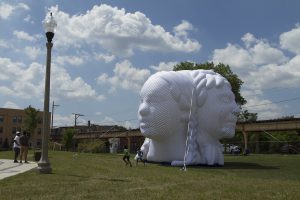
FM: Yeah. It takes time, there are pros and cons. Number one is that the mobility aspect is great. Not only do we pop up every Wednesday for the summer, we also have picked out a couple weekends where we do fairs and things. We’ve been at the Poetry Foundation, in front of the National Museum of Mexican Art, we did the Re-Imagining Englewood celebration with Tonika Johnson and TRACE as a partner, and then Boxville. So we try to identify spaces that are doing something and figuring out a way that a large inflatable with some history can maybe embellish that a little bit. Which is very different.
On the river we controlled a lot of the programming aspects, we curated what we wanted to do, but in this one we really made efforts to find organizations that are already doing something, and figure out how to start having a dialogue about, “ok, how can we support that thing?” Sometimes that’s not only bringing the balloon but also, hey we’ll pay for a DJ, or we’ll just put some money down on this, or we try to figure out what that negotiation is, and that’s kind of an important part of what we do. We also have two really great docents/handlers Latrell Walton and Eric Perez, They’re out there inflating, but also having these casual conversations and getting to know people. Sometimes it’s deep conversations, but most times people want to talk about their relationship to the thing. Like, “Oh, I went to DuSable High School, let me tell you about DuSable High School” you know, or du Sable, and so that’s the thing that’s really great.
It’s slow, it’s quiet. I think people are going out of their way to find it. I have found a couple people coming from up north, or out of their way to see it, but for the most part the audience is the people immediately adjacent to the space where it is.
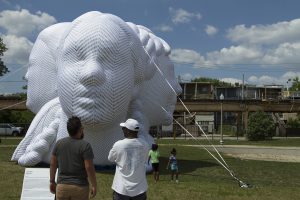
MS: What have been some challenges of getting it going and doing it?
FM: Lots of them.
JHS: Yeah, lots of challenges, but public art has a lot of challenges. I think we’re dealing with some complexities, you know, in public space you’ve got a lot of different moving pieces, insurance considerations, safety. We have a lot of moving pieces all at once and the CTA is a huge bureaucracy. You know, their main job is to get people where they need to go on time, safely. We’re working real hard to maybe tweak the infrastructure just a little bit and put some culture in the mix, and as a first step to build on that.
FM: And in a different way. You know, I think the CTA has an understanding of how they work with art, right. Performances happen down below in the tunnels on the Red Line or wherever else. Artwork is positioned in the stations, which is great. Sometimes there’s an opportunity, there’s an advertising model. So if you think of your artwork in the same sort of way Crown Royal thinks about doing a [train] wrap, then that’s fine.
So we try to figure out, well what if the permits that work down on the platform could be moved to actually be on the train? Instead of people walking through the train doing performances, but then running away from authorities, or soliciting for money, what if they were already paid? Then they wouldn’t have to solicit for money, and you wouldn’t have to put your eyes down as this really great thing is happening. What if we put a little more thought into the curation of how that actually functions? So again, it’s working with the model that’s already there and not pulling or putting too much pressure on that, because then it just gets dropped to the side.
It’s understanding that system, but then also understanding that it’s a very slow moving beast of a thing that’s taken decades and decades to cultivate. We’re not going to come in over night and just change it. So we plant the seeds, and then we document well the potential of those things, we get a following. To appreciate that, like he talked about, the post about, “Oh, for $2.50 I can have a museum experience on my way in to work.” That’s really a powerful statement.
JHS: Yeah. The end of that post was, “Look up.” and I thought that was — because I look down on the train all the time.
FM: We’ve all done that, because we don’t want to make eye contact.
JHS: It was interesting because he looked up, because some of our text is on the ceiling, and he got to read the didactic because he looked up. So I like that, you know. Maybe looking up you might see this sort of Godzilla-like Founders balloon looking in the window.
FM: Yeah. You make some connections between what’s outside and inside, also.
MS: Especially in a city like Chicago that doesn’t have a big institution that’s also free all the time. They have days that are free, but there’s not that tradition. So to say, yeah it is significant to have a $2.50 entrance to a museum, essentially.
JHS: Yeah, and a lot of our installations are free — period.
FM: They’re all free! Yeah, the $2.50 is the most expensive installation we’ve had! And it’s not for us, it’s for the train.
JHS: Right. You totally got it. That’s really important, in terms of free public art. That’s important to us. Looking at other big cities, something that we thought a lot about, there are also really large funding mechanisms, foundations, for public art in other big cities. I think that’s something that we’re hoping to help Chicago out with a little bit, build on our successes and cultivate that culture of putting money, a lot of money, into quality public art. You know, because those other big cities on the coasts, they do have that. I think Chicago would be better off if that culture was built up and better funded.
FM: One of our dreams is to get a big budget; in a similar way that a museum has a big budget for a show or something like that, a significant one; and then take that out into the neighborhoods. Bring the installers, bring all the same quality and attention that goes into the interior, to do that in a neighborhood where you don’t necessarily have the same amount of control. Like, how can you have the big show outside of the walls?
We’re showing them you can still talk about collections. You can still have the presence of those objects, the content, the conceptual rigor, all that stuff can happen. It can still increase numbers in your museum, at the same time, without people having to physically be there to come to the temple. You just spread it out a little bit. It’s a different way of thinking. There are museums in cities thinking about this, and doing this, and we just have one of many models for how that works.
JHS: So the final piece in the puzzle [for this project] is Soul El, which Avery R. Young is curating, and it’s performances on the trains. So there’s gonna be pop up, lunchtime performances, poetry and music mostly, that’s going to be during the regular service on the Green Line.
FM: Now it’s looking like it’s in September. This is just an example of once again, that thing I talk about, about getting permits to come from up to down. These are new platforms, that once there’s a precedent for how it works, it can be expanded upon. It’s hard. It’s just hard to do some of these things because they haven’t been done before. Now, if we want to go back to the river, you can imagine how hard floating a barge on the river in 2017 was. No one had done this in the way that we were doing it. Now it’s like, oh we got a model. We can go back, we can do it again, they’ll be much easier. So we’re hoping the same thing happens with the CTA – that we start this, we plant the seeds, we see the potential, and then we can expand upon it. One day maybe they’ll all be going at the same time — rivers, and trains, and dirigibles…
JHS: And airplanes. Ha!
FM: All types of stuff.
MS: It feels like you’re doing that. Like you’re figuring out, ok how do we work with the parks? Then you figure that out, and then you move to the next thing. How do we work with the train system? Then you figure that out. It feels like that. You’re figuring out these systems that are normally pretty inaccessible.
FM: I mean, you’re 100% right. We figured out the parks the first year. We were in Calumet Park in Southeast. That was the big one: figuring out our network within the parks, and the potential of all these park fieldhouses. We figured that out. Then that was the easiest relationship when we did the river. The parks were easy because they already had trust, we knew how to work with each other, they knew we had follow through and commitment. We knew all that stuff. Then the CDOT, so Department of Transportation and the 2FM (Fleet and Facility Management) on the rivers and all that, that was very challenging. We figured that out and now a lot of those people are our friends, so we can call them up. So, CTA for us has been a new relationship. We’re figuring that out. It’s been productive, but slow.
JHS: It’s been slow, but not… we spent 6 months trying to figure out who owns the river wall, you know, for the Chicago river, because we had to install bollards to tie a barge off. So, the CTA has been slow, but compared to the river, ha! Like a cakewalk.
FM: It was a lot of work just to figure out, like, a 10-inch piece of metal. Oh my god, you wouldn’t believe.
MS: But also, it’s important that you’re doing it, I think, the proper way. Because you could just do it guerilla style. There’s so many advantages to just doing it guerilla.
FM: Oh, completely. We could totally do that. You got it: that is a part of it. That ends up being part of the artwork, is actually figuring out how to legitimately do it and think about the CTA as a partner versus just a platform for us to run in and out of. Of course people do performances on trains all the time, it’s not that difficult and generally they just turn a blind eye. But it’s like really creating a structure where it’s a new platform to be utilized, and not guerilla. So yeah, there is that temptation.
JHS: Not to say it’s not frustrating sometimes, but it’s totally part of the artwork and the practice. We’re trying to build a museum with the city, you know, so it’s a team project for sure. Yeah.

Featured Image: Floating Museum’s 2019 sculpture titled Founders; with the busts of Jean Baptiste Point du Sable, an Unnamed Boy, and former Chicago Mayor Harold Washington visible; installed on the grass in Hadiya Pendleton Park in Chicago. The 25 foot tall sculpture is made of a primarily white fabric with a grey, geometric pattern all over, is inflated like a balloon, and held in place by thin white straps. In the background are decorative lamp posts, playground equipment, trees, and neighborhood homes. Above is a blue sky dotted with white, puffy clouds. Photo by Michael Sullivan.
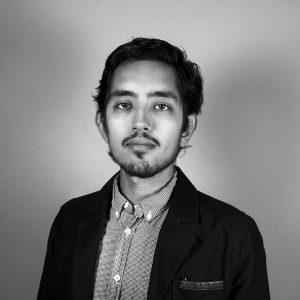 Michael Sullivan is a photographer and documentary filmmaker born and raised in El Paso, TX. He studied photography, painting and printmaking at the University of Texas, Austin. After moving to Chicago he co-founded the production company On The Real Film in 2011. He lives and works in Chicago, and is online everywhere @ontherealfilm.
Michael Sullivan is a photographer and documentary filmmaker born and raised in El Paso, TX. He studied photography, painting and printmaking at the University of Texas, Austin. After moving to Chicago he co-founded the production company On The Real Film in 2011. He lives and works in Chicago, and is online everywhere @ontherealfilm.
